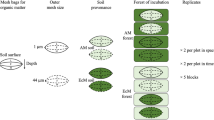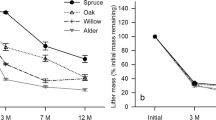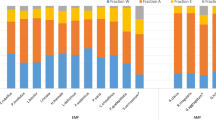Abstract
Slower leaf litter decomposition rates for trees associated with ectomycorrhizal (ECM) fungi compared to arbuscular mycorrhizal (AM) fungi may lead to the development of conservative nitrogen cycling and accumulation of soil organic matter in surface soils of ECM-dominated forests. Slower decomposition is hypothesized to occur via two often-confounded mechanisms: production of lower quality litter by ECM-associated trees compared to AM-associated trees and competition for nitrogen between ECM and saprotrophic decomposers in ECM-dominated stands. To disentangle the effects of litter quality and stand mycorrhizal type on decomposition, we measured litter mass loss rates of two AM species higher and two AM species similar in chemical quality to two ECM species. Leaf litter was decomposed for two years in neighboring ECM- and AM-dominated stands of a wet tropical montane forest. Litter phosphorus (P) was the strongest predictor of decomposition rates across all species, with no effect of litter mycorrhizal type on decomposition rates. Only one species, which exhibited intermediate litter chemical quality and decomposition rate, decomposed significantly faster in AM- compared to ECM-dominated stands. Leaf litter decomposition rates cannot be predicted directly from litter mycorrhizal type or stand mycorrhizal type because litter chemical quality and environmental conditions mediate the manifestation of slower decomposition in ECM stands.





Similar content being viewed by others
Data availability
Data are available upon request from the corresponding author.
References
Andersen KM, Endara MJ, Turner BL, Dalling JW (2012) Trait-based community assembly of understory palms along a soil nutrient gradient in a lower montane tropical forest. Oecologia 168:519–531. https://doi.org/10.1007/s00442-011-2112-z
Averill C (2016) Slowed decomposition in ectomycorrhizal ecosystems is independent of plant chemistry. Soil Biol Biochem 102:52–54. https://doi.org/10.1016/j.soilbio.2016.08.003
Averill C, Bhatnagar JM, Dietze MC et al (2019) Global imprint of mycorrhizal fungi on whole-plant nutrient economics. Proc Natl Acad Sci USA. https://doi.org/10.1073/pnas.1906655116
Averill C, Turner BL, Finzi AC (2014) Mycorrhiza-mediated competition between plants and decomposers drives soil carbon storage. Nature 505:543–545. https://doi.org/10.1038/nature12901
Baldrian P, Kolaiřík M, Štursová M et al (2012) Active and total microbial communities in forest soil are largely different and highly stratified during decomposition. ISME J. https://doi.org/10.1038/ismej.2011.95
Blair JM (1988) Nitrogen, sulfur and phosphorus dynamics in decomposing deciduous leaf litter in the southern appalachians. Soil Biol Biochem 20:693–701. https://doi.org/10.1016/0038-0717(88)90154-X
Brookshire ENJ, Thomas SA (2013) Ecosystem consequences of tree monodominance for nitrogen cycling in lowland tropical forest. PLoS ONE 8:7. https://doi.org/10.1371/journal.pone.0070491
Brzostek ER, Dragoni D, Brown ZA, Phillips RP (2015) Mycorrhizal type determines the magnitude and direction of root-induced changes in decomposition in a temperate forest. New Phytol 206:1274–1282. https://doi.org/10.1111/nph.13303
Camenzind T, Hättenschwiler S, Treseder KK et al (2018) Nutrient limitation of soil microbial processes in tropical forests. Ecol Monogr 88:4–21. https://doi.org/10.1002/ecm.1279
Cavelier J, Solis D, Jaramillo MA (1996) Fog interception in montane forests across the Central Cordillera of Panama. J Trop Ecol 12:357–369. https://doi.org/10.1017/S026646740000955X
Chuyong GB, Newbery DM, Songwe NC (2002) Litter breakdown and mineralization in a central African rain forest dominated by ectomycorrhizal trees. Biogeochemistry. https://doi.org/10.1023/A:1020276430119
Clemmensen KE, Bahr A, Ovaskainen O et al (2013) Roots and associated fungi drive long-term carbon sequestration in boreal forest. Science 339:1615–1618. https://doi.org/10.1126/science.1231923
Clemmensen KE, Finlay RD, Dahlberg A et al (2015) Carbon sequestration is related to mycorrhizal fungal community shifts during long-term succession in boreal forests. New Phytol. https://doi.org/10.1111/nph.13208
Cleveland CC, Townsend AR, Schmidt SK (2002) Phosphorus limitation of microbial processes in moist tropical forests: evidence from short-term laboratory incubations and field studies. Ecosystems 5:680–691. https://doi.org/10.1007/s10021-002-0202-9
Cleveland CC, Reed SC, Townsend AR (2006) Nutrient regulation of organic matter decomposition in a tropical rain forest. Ecology 87:492–503. https://doi.org/10.1890/05-0525
Cornelissen JHC, Aerts R, Cerabolini B et al (2001) Carbon cycling traits of plant species are linked with mycorrhizal strategy. Oecologia 129:611–619. https://doi.org/10.1007/s004420100752
Cornwell WK, Cornelissen JHC, Amatangelo K et al (2008) Plant species traits are the predominant control on litter decomposition rates within biomes worldwide. Ecol Lett 11:1065–1071. https://doi.org/10.1111/j.1461-0248.2008.01219.x
Corrales A, Mangan SA, Turner BL, Dalling JW (2016) An ectomycorrhizal nitrogen economy facilitates monodominance in a neotropical forest. Ecol Lett 19:383–392. https://doi.org/10.1111/ele.12570
Craig ME, Turner BL, Liang C et al (2018) Tree mycorrhizal type predicts within-site variability in the storage and distribution of soil organic matter. Glob Chang Biol 24:3317–3330. https://doi.org/10.1111/gcb.14132
Currie WS, Aber JD (1997) Modeling leaching as a decomposition process in humid montane forests. Ecology 78:1844–1860. https://doi.org/10.1890/0012-9658(1997)078[1844:MLAADP]2.0.CO;2
Cusack DF, Chou WW, Yang WH et al (2009) Controls on long-term root and leaf litter decomposition in neotropical forests. Glob Chang Biol. https://doi.org/10.1111/j.1365-2486.2008.01781.x
Dalling JW, Turner BL (2021) Fortuna Forest Reserve, Panama: Interacting Effects of Climate and Soils on the Biota of a Wet Premontane Tropical Forest. The Smithsonian Institution. Book. https://doi.org/10.5479/si.14315990.v1
Fernandez CW, Kennedy PG (2016) Revisiting the “Gadgil effect”: do interguild fungal interactions control carbon cycling in forest soils? New Phytol 209:1382–1394. https://doi.org/10.1111/nph.13648
Fernandez CW, See CR, Kennedy PG (2019) Decelerated carbon cycling by ectomycorrhizal fungi is controlled by substrate quality and community composition. New Phytol 226:569–582. https://doi.org/10.1111/nph.16269
Gadgil RL, Gadgil PD (1971) Mycorrhiza and litter decomposition. Nature 233:133. https://doi.org/10.1038/233133a0
Gholz HL, Wedin DA, Smitherman SM et al (2000) Long-term dynamics of pine and hardwood litter in contrasting environments: toward a global model of decomposition. Glob Chang Biol. https://doi.org/10.1046/j.1365-2486.2000.00349.x
Harmon ME, Baker GA, Spycher G, Greene SE (1990) Leaf-litter decomposition in the Picea/tsuga forests of Olympic National Park, Washington, U.S.A. For Ecol Manag 31:55–66. https://doi.org/10.1016/0378-1127(90)90111-N
Harmon ME, Silver WL, Fasth B et al (2009) Long-term patterns of mass loss during the decomposition of leaf and fine root litter: an intersite comparison. Glob Chang Biol 15:1320–1338. https://doi.org/10.1111/j.1365-2486.2008.01837.x
Jones JM, Heath KD, Ferrer A et al (2018) Wood decomposition in aquatic and terrestrial ecosystems in the tropics: contrasting biotic and abiotic processes. FEMS Microbiol Ecol 95:fiy223. https://doi.org/10.1093/femsec/fiy223
Keller AB, Phillips RP (2019) Leaf litter decay rates differ between mycorrhizal groups in temperate, but not tropical, forests. New Phytol 222:556–564. https://doi.org/10.1111/nph.15524
Koele N, Dickie IA, Oleksyn J et al (2012) No globally consistent effect of ectomycorrhizal status on foliar traits. New Phytol 196:845–852. https://doi.org/10.1111/j.1469-8137.2012.04297.x
Kohler A, Kuo A, Nagy LG et al (2015) Convergent losses of decay mechanisms and rapid turnover of symbiosis genes in mycorrhizal mutualists. Nat Genet 47:410-U176. https://doi.org/10.1038/ng.3223
Koide RT, Fernandez C, Malcolm G (2014) Determining place and process: functional traits of ectomycorrhizal fungi that affect both community structure and ecosystem function. New Phytol 201:433–439. https://doi.org/10.1111/nph.12538
Lin G, Guo D, Li L et al (2018) Contrasting effects of ectomycorrhizal and arbuscular mycorrhizal tropical tree species on soil nitrogen cycling: the potential mechanisms and corresponding adaptive strategies. Oikos 127:518–530. https://doi.org/10.1111/oik.04751
Lindahl BD, Ihrmark K, Boberg J et al (2007) Spatial separation of litter decomposition and mycorrhizal nitrogen uptake in a boreal forest. New Phytol. https://doi.org/10.1111/j.1469-8137.2006.01936.x
Lindahl BD, Tunlid A (2015) Ectomycorrhizal fungi—potential organic matter decomposers, yet not saprotrophs. New Phytol 205:1443–1447. https://doi.org/10.1111/nph.13201
Mayor JR, Henkel TW (2006) Do ectomycorrhizas alter leaf-litter decomposition in monodominant tropical forests of Guyana? New Phytol 169:579–588. https://doi.org/10.1111/j.1469-8137.2005.01607.x
McGuire KL, Zak DR, Edwards IP et al (2010) Slowed decomposition is biotically mediated in an ectomycorrhizal, tropical rain forest. Oecologia 164:785–795. https://doi.org/10.1007/s00442-010-1686-1
Meentemeyer V (1978) Macroclimate and lignin control of litter decomposition rates. Ecology 59:465–472. https://doi.org/10.2307/1936576
Melillo JM, Aber JD, Muratore JF (1982) Nitrogen and lignin control of hardwood leaf litter decomposition dynamics. Ecology 63:621–626. https://doi.org/10.2307/1936780
Midgley MG, Brzostek E, Phillips RP (2015) Decay rates of leaf litters from arbuscular mycorrhizal trees are more sensitive to soil effects than litters from ectomycorrhizal trees. J Ecol 103:1454–1463. https://doi.org/10.1111/1365-2745.12467
Oksanen J, Blanchet FG, Friendly M et al (2019) vegan: Community Ecology Package. R package version 2.5-6. https://CRAN.R-project.org/package=vegan
Orwin KH, Kirschbaum MUF, St John MG, Dickie IA (2011) Organic nutrient uptake by mycorrhizal fungi enhances ecosystem carbon storage: a model-based assessment. Ecol Lett 14:493–502. https://doi.org/10.1111/j.1461-0248.2011.01611.x
Phillips RP, Brzostek E, Midgley MG (2013) The mycorrhizal-associated nutrient economy: a new framework for predicting carbon-nutrient couplings in temperate forests. New Phytol 199:41–51. https://doi.org/10.1111/nph.12221
Powers JS, Montgomery RA, Adair EC et al (2009) Decomposition in tropical forests: a pan-tropical study of the effects of litter type, litter placement and mesofaunal exclusion across a precipitation gradient. J Ecol. https://doi.org/10.1111/j.1365-2745.2009.01515.x
Prada CM, Morris A, Andersen KM et al (2017) Soils and rainfall drive landscape-scale changes in the diversity and functional composition of tree communities in premontane tropical forest. J Veg Sci 28:859–870. https://doi.org/10.1111/jvs.12540
Prescott CE (2010) Litter decomposition: what controls it and how can we alter it to sequester more carbon in forest soils? Biogeochemistry 101:133–149. https://doi.org/10.1007/s10533-010-9439-0
Read DJ, Perez-Moreno J (2003) Mycorrhizas and nutrient cycling in ecosystems—a journey towards relevance? New Phytol 157:475–492. https://doi.org/10.1046/j.1469-8137.2003.00704.x
Sanchez PA, Bandy DE, Villachica JH, Nicholaides JJ (1982) Amazon Basin soils: management for continuous crop production. Science 216:821–827. https://doi.org/10.1126/science.216.4548.821
Schilling EM, Waring BG, Schilling JS, Powers JS (2016) Forest composition modifies litter dynamics and decomposition in regenerating tropical dry forest. Oecologia. https://doi.org/10.1007/s00442-016-3662-x
Schmidt MWI, Torn MS, Abiven S et al (2011) Persistence of soil organic matter as an ecosystem property. Nature 478:49–56. https://doi.org/10.1038/nature10386
Schreeg LA, Mack MC, Turner BL (2013) Nutrient-specific solubility patterns of leaf litter across 41 lowland tropical woody species. Ecology 94:94–105
Sluiter A, Hames B, Ruiz RO et al (2008) Determination of structural carbohydrates and lignin in biomass. Lab Anal Proced 1617:1–16
Smith GR, Wan J (2019) Resource-ratio theory predicts mycorrhizal control of litter decomposition. New Phytol 223:1595–1606. https://doi.org/10.1111/nph.15884
Sokal RR, Rohlf FJ (1970) Biometry. The principles and practice of statistics in biological research. Science. https://doi.org/10.1126/science.167.3915.165
Soudzilovskaia NA, van der Heijden MGA, Cornelissen JHC et al (2015) Quantitative assessment of the differential impacts of arbuscular and ectomycorrhiza on soil carbon cycling. New Phytol 208:280–293. https://doi.org/10.1111/nph.13447
Sun T, Hobbie SE, Berg B et al (2018) Contrasting dynamics and trait controls in first-order root compared with leaf litter decomposition. Proc Natl Acad Sci USA. https://doi.org/10.1073/pnas.1716595115
Talbot JM, Allison SD, Treseder KK (2008) Decomposers in disguise: mycorrhizal fungi as regulators of soil C dynamics in ecosystems under global change. Funct Ecol 22:955–963. https://doi.org/10.1111/j.1365-2435.2008.01402.x
Taylor BR, Prescott CE, Parsons WJF, Parkinson D (1991) Substrate control of litter decomposition in four Rocky Mountain coniferous forests. Can J Bot 69:2422–2550. https://doi.org/10.1139/b91-281
R Core Team (2019) R: a language and environment for statistical computing. R Foundation for Statistical Computing, Vienna, Austria. https://www.R-project.org/
Torti SD, Coley PD, Kursar TA (2001) Causes and consequences of monodominance in tropical lowland forests. Am Nat 157:141–153. https://doi.org/10.1086/318629
Trofymow JA, Moore TR, Titus B et al (2002) Rates of litter decomposition over 6 years in Canadian forests: influence of litter quality and climate. Can J for Res 32:789–804. https://doi.org/10.1139/x01-117
Trofymow JA, Preston CM, Prescott CE (1995) Litter quality and its potential effect on decay rates of materials from Canadian forests. Water, Air, Soil Pollut. https://doi.org/10.1007/BF01182835
van Huysen TL, Perakis SS, Harmon ME (2016) Decomposition drives convergence of forest litter nutrient stoichiometry following phosphorus addition. Plant Soil 406:1–14. https://doi.org/10.1007/s11104-016-2857-6
Venables WN, Ripley BD (2002) Modern Applied Statistics with S, 4th edn. Springer, New York
Walker TW, Syers JK (1976) Fate of phosphorus during pedogenesis. Geoderma 15:1–19. https://doi.org/10.1016/0016-7061(76)90066-5
Waring BG (2012) A Meta-analysis of climatic and chemical controls on leaf litter decay rates in tropical forests. Ecosystems 15:999–1009. https://doi.org/10.1007/s10021-012-9561-z
Wieder WR, Cleveland CC, Townsend AR (2009) Controls over leaf litter decomposition in wet tropical forests. Ecology 12:3333–3341. https://doi.org/10.1890/08-2294.1
Zhang D, Hui D, Luo Y, Zhou G (2008) Rates of litter decomposition in terrestrial ecosystems: global patterns and controlling factors. J Plant Ecol 1:85–93. https://doi.org/10.1093/jpe/rtn002
Acknowledgements
We appreciate field assistance from Evidelio Garcia and Carlos Espinosa, and lab assistance from Rachel Van Allen and Helen Fisher. This research was funded by the Clark Research Award, Ferguson Fund, and the University of Illinois Graduate College Dissertation Travel Grant to GSS. The National Science Foundation Integrative Graduate Education and Research Traineeship Program (NSF IGERT 1069157) and the Illinois Distinguished Fellowship supported GSS. The Smithsonian Tropical Research Institute provided logistical support at the Fortuna Forest Reserve.
Funding
This research was funded by the Clark Research Award, Ferguson Fund, and the University of Illinois Graduate College Dissertation Travel Grant to GSS. The National Science Foundation Integrative Graduate Education and Research Traineeship Program (NSF IGERT 1069157) and the Illinois Distinguished Fellowship supported GSS. The Smithsonian Tropical Research Institute provided logistical support at the Fortuna Forest Reserve.
Author information
Authors and Affiliations
Contributions
GSS and WHY conceived of and designed the study in consultation with JD; GSS conducted the study, processed the samples, analyzed the data, and wrote the manuscript; WHY edited the manuscript with contributions from JD.
Corresponding author
Ethics declarations
Conflict of interest
The authors declare that they have no conflict of interest.
Additional information
Publisher's Note
Springer Nature remains neutral with regard to jurisdictional claims in published maps and institutional affiliations.
Responsible Editor: Feng Zhou.
Supplementary Information
Below is the link to the electronic supplementary material.
Rights and permissions
About this article
Cite this article
Seyfried, G.S., Dalling, J.W. & Yang, W.H. Mycorrhizal type effects on leaf litter decomposition depend on litter quality and environmental context. Biogeochemistry 155, 21–38 (2021). https://doi.org/10.1007/s10533-021-00810-x
Received:
Accepted:
Published:
Issue Date:
DOI: https://doi.org/10.1007/s10533-021-00810-x




